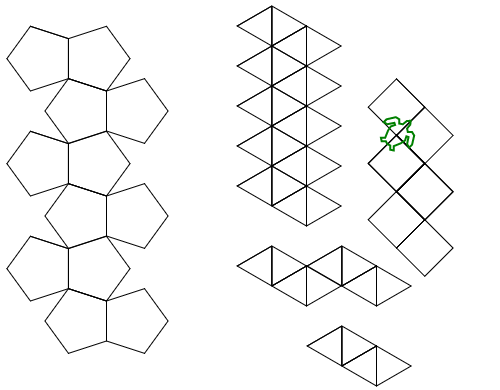#Logo, 200 bytes#
TO p:x:y:d:n:s
for[i 1:n][pu setxy:x:y-:d*:i if:i<>6[pd]repeat 2[repeat:s[fd 40 rt 360/:s]repeat:s+2[fd 40 lt 360/:s]rt 720/:s]]END
p 0 200 40 7 3
p 70 0 80 2 3
p -200 200 105 3 5
rt 45
p 90 90 56 2 4
Interpreter at http://www.calormen.com/jslogo/# It is assumed the turtle is pointing North before the program is run. Use the cs command to clear the screen, point the turtle north, and place it at the origin in the centre of the screen.

The basic unit of all the above nets is a pair of back to back polygons. These are arranged in 2 staggered rows, making a subunit of 4 polygons which can be translated vertically to make all the nets (except the octahedron, which hitches a ride on the drawing of the icosahedron and tetrahedron). The subunit forms 1 tetrahedron net, 1/5 of the icosahedron net, 1/3 of the dodecahedron net and 2/3 of the cube net (two subunits are drawn, with the middle two squares overlapping.)
Ungolfed code
TO p :x :y :d :n :s ;x,y=starting point d=negative vertical offset for each iteration n=#of iterations s=# of sides on polygon
for[i 1 :n][ ;iterate n times
pu ;pen up
setxy :x :y- :d* :i ;move pen to start of iteration
if :i<>6[pd] ;pen down (supressed for i=6 to enable part of octahedron to be drawn with icosahedron)
repeat 2[ ;draw lower row of 2 polygons, then upper row of 2 polygons
repeat :s[fd 40 rt 360/ :s] ;starting at lower left of polygon facing up, draw righthand polygon
repeat :s+2[fd 40 lt 360/ :s] ;starting at lower right of polygon facing up, draw lefthand polygon, duplicating last two sides
rt 720/ :s ;return turtle to upwards facing in order to draw second row
]
]
END
cs
p 0 200 40 7 3 ;draw icosahedron and left side of octahedron (6th iteration is suppressed)
p 70 0 80 2 3 ;draw right side of octahedron, and tetrahedron
p -200 200 105 3 5 ;draw dodecahedron
rt 45 ;turn turtle in preparation for drawing cube
p 90 90 56 2 4 ;draw cube